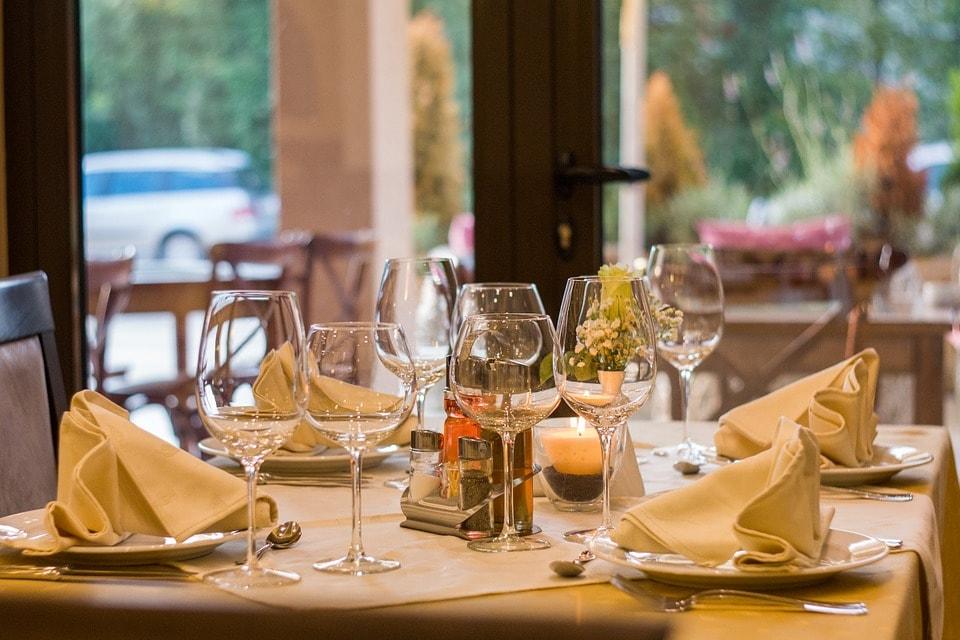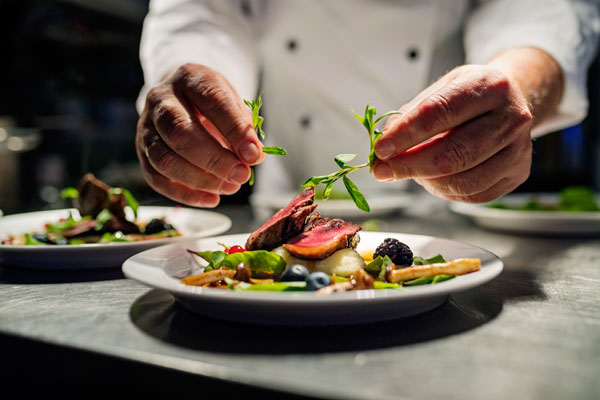Examples of gourmet restaurant websites
In France, home of haute cuisine, the gourmet restaurant website has become the digital equivalent of a carefully prepared plate: it's the first thing a guest 'tastes'. In a landscape where there are around 175,000 restaurants and more than 630 starred addressesEvery restaurant needs to create a digital showcase that evokes the same emotion as the arrival of an amuse-bouche. But a simple slideshow of dishes is no longer enough: today's Internet user demands a fluid, immersive experience, aligned with the personality of the chef and the culinary promise of the establishment.
The aim of this article is twofold:
-
Illustrate what will distinguish the best sites for French gastronomic establishments in 2025, through case studies.
-
Details the strategic choices - design, technical, editorial - that transform a site into a genuine sales lever, capable of booking, selling gift cards, telling a story and, above all, making people want to walk through the door.

2025 trends for gourmet restaurant websites: beyond the showcase site, the digital ecosystem
-
Vertical video snack-content for Reels and TikTok, adapted to the site via a full-height module.
-
VR discovery virtual tour of the cellar or vegetable garden, available on Meta Quest headsets or gyroscopic smartphones.
-
Accessibility RGAA high contrast, keyboard navigation, alternative text on each visual.
-
Artificial intelligence " Multilingual reservation chat, trained on the basis of seasonal menus, able to propose a personalised food and wine pairing or a tasting adapted to allergies.
" L'Arôme "Paris 8ᵉ
In the heart of the Golden Triangle, this star restaurant now has a bilingual French-English site; German and Korean will be rolled out by the end of the year. Navigation alternates between immersive full page and dynamic columnslike a gastronomic score. The gift vouchers can be ordered in four clicks, with secure payment: the operation now accounts for 18 % of sales excluding meals. The visual storytelling plays on chiaroscuro: photos with a shallow depth of field, short texts, Art Deco inspiration revisited.
" L'Atelier des Augustins "Lyon Presqu'île
Here, the home page features a entrance animation where the flame of a furnace becomes a logo. Visit smooth scrolling then leads the visitor to an animated menu that reveals each dish by hovering over it. Reservations are integrated into an in-house module connected to the restaurant's PMS: the service thus avoids double entry and reduces "no-shows" by 22 %. The colour scheme - ochre, terracotta, copper - subtly evokes Lyon's butchery tradition, while at the same time asserting a contemporary dimension.
" Villa Madie "Cassis
Overlooking the Mediterranean, this double Michelin-starred establishment plays the scroll storytelling The screen not only scrolls vertically, but also sideways at times, creating a sense of coastal immersion. A sticky menu remains visible and accessible, whatever the section. Reservations can be paid by online deposit; a "smart pricing" engine adjusts the pre-authorisation amount according to the time slot, reducing last-minute cancellations.
" Villa Morelia "Alpes de Haute Provence
A manor house converted into a hotel-restaurant, this establishment offers a wide range of services. gastronomic section distinct from the hotel offer. The burgundy and warm grey colours evoke the vaulted cellar where the grands crus are aged. The social networks, highlighted in the header, feed a real-time flow of images; Instagram publications illustrating the preparation of the dinner are immediately echoed on the site, creating a bridge between the short digital time and the long time of tasting.
" The Pavillon des Boulevards "Bordeaux
The design plays the halftone photo It's the perfect backdrop: low-angled light, silhouettes of trees, reflections on a glass of Pessac-Léognan. The handwritten typography, reminiscent of a 'Parisian' pen, underlines the artisanal dimension. From the outset, the site mentions the recognition of the Michelin Guide The 'Privatisation' page offers online quotes for weddings and seminars, while the gift shop directly integrates an e-commerce solution.
Visual design: combining aesthetics and performance
First and foremost, a gourmet restaurant sells a sensual experience. Visitors can almost 'smell' the scent of truffles or the freshness of a sea bass. To achieve this :
-
High-resolution photographsThese are produced by a specialist food photographer, with artistic direction in line with the chef's signature;
-
Adapted pallet identity: deep colours for a cosy table, pastel shades for a seaside home;
-
Light entertainment (parallax, micro-interactions): they humanise the experience without slowing down loading (time budget: < 2.5 s on mobile).
The classic mistake is to overload the interface with too many auto-play videos, filters or exotic typography. Sobriety remains a safe bet: emptiness plays the role of silence, essential for making each visual note vibrate.
Online menu: the menu as a seductive device
The menu must be just a click away from the home page. On the desktop, a full-screen display can immerse the user in the world of taste; on mobile, an accordion or peek & pop format makes the site easy to read. Each dish is accompanied by :
-
From a sensory description short: three lines are enough to evoke texture, origin and association;
-
A allergen tag visible, a guarantee of transparency;
-
From a photo only if it adds narrative value (avoid the catalogue effect).
Think downloadable PDF "signature menu" version, updated in real time via a CMS to avoid obsolete printouts.
Instant booking: simplicity equals conversion
In 2025, a website without an integrated reservation module for a gourmet restaurant looks as anachronistic as a handwritten map with sauce all over it. Best practice :
-
Direct integration a table management tool (SevenRooms, TheFork Manager, Guestonline, etc.);
-
Payment on account or bank card in imprint: the no-show rate generally falls from 30 % to 50 % ;
-
mobile-first UX 64 % of top-of-the-range bookings are now made from a smartphone, often late at night.
Be careful not to confine the user: telephone reservations must remain visible, particularly for complex allergy requests or private events.
Practical information: the most popular section
Address, opening hours, contact details: these are prosaic but vital details that must be included in the header or footer of each page. Add :
-
Direct link to Google / Apple Maps ;
-
Calendar widget indicating days of exceptional closure;
-
WhatsApp number or messaging platform for asynchronous exchanges.
Visitors looking for a number won't read your fifteen lines of storytelling: make their search easier or they'll move on to the next establishment.
Image gallery: the art of dosage
A carousel of tempting shots is better than an exhaustive album. Think visual tour :
-
Start outside or in the room to set the scene;
-
Diving then in the kitchen, the gestures, the plate ;
-
Close on a detail - an engraved knife handle, an edible flower - that suspends time.
Each photo must be compressed without losing quality (WebP, Lazy Loading) to maintain performance.
Opinions and testimonials: top-of-the-range social proof
In gastronomy, the professional critic (Michelin Guide, Gault & Millau, Omnivore) remains the arbiter, but the customer's opinion reassures the foreign traveller. Best practice :
-
Quoting extracts of press reviews on a neutral background, elegant typography ;
-
Integrating a widget TripAdvisor or Google reviews, filtered to display only 4-5 star ratings - authorised by the GTC if the ratings remain visible when clicked;
-
Reply public feedback: a personal word from the chef shows that he is listening and humanises the relationship.
Social networks and newsletters: building loyalty beyond the meal
The social link often begins before the visit. A few levers:
-
Instagram for the culinary staging and live backstage;
-
LinkedIn for recruitment announcements and wine partnerships;
-
Newsletter monthly, with a focus on storytelling: a new menu, a schedule of cookery classes, and food and wine pairings with commentary.
A discreet registration module - pop-over notified after thirty seconds of scrolling - avoids aggression. Segment the base: locals vs. tourists, gourmets vs. mixology enthusiasts, to adapt frequency and content.
"About us": recounting the soul of the place
This section is not just a biography of the chef. It must give a face to the brigade, evoke the history of the producers, reveal the sustainable philosophy or the signature gesture. A good narrative thread :
-
Origin Why this place?
-
Commitment raw materials, seasonality, short distribution channels.
-
Vision The emotion we seek in every service.
Use the visual storytelling These include a photo of a hand training a micro-herb, a short video of a harvest at dawn, and a black-and-white portrait of the chef at the pass.
Methodological approach: how to design or redesign your restaurant website
-
Brand audit
-
Clarify positioning: chic bistro, gourmet restaurant, Michelin-starred inn.
-
Identify the "emotional moments" to be transposed into digital (bread service, flambéing in the dining room, etc.).
-
-
UX / UI study
-
Personas: foreign tourist, local couple, gourmet business.
-
Path: inspiration → validation → reservation → loyalty.
-
-
Interactive prototype
-
Wireframes without colour to validate the information hierarchy.
-
Think aloud" user tests: observing where the eye wanders.
-
-
Content production
-
Photo session orchestrated like a film shoot: moodboard, food stylist, continuous lighting.
-
SEO-first copywriting: targeted keywords ("Michelin-starred restaurant Nantes", "plant-based tasting menu"), but text written for people first and foremost.
-
-
Development & performance
-
Headless framework (Next.js, Nuxt) or bespoke CMS (Strapi) to reconcile creative freedom and loading times.
-
Intelligent caching: Cloudflare, Netlify Edge, Core Web Vitals optimisation.
-
-
Launch & follow-up
-
Soft launch for staff and loyal customers, feedback gathering.
-
Monthly reporting: conversion rates, average shopping baskets, geographical origin of bookings.
-








